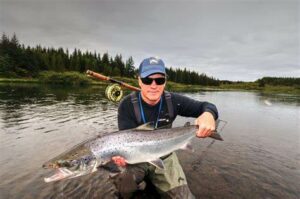Fly fishing for salmon in Iceland is a popular and exciting activity for anglers. Iceland is known for its pristine rivers and abundant salmon populations, making it a prime destination for fly fishing enthusiasts.
Here are some key points to know about fly fishing for salmon in Iceland:
- Seasons: Salmon fishing in Iceland typically runs from mid-June to mid-September. The peak season for salmon runs varies depending on the river and location, so it’s best to check with local authorities or fishing lodges for specific dates.
- Rivers: Iceland is home to numerous salmon rivers, each offering unique fishing experiences. Some of the well-known salmon rivers include the Laxá in Adaldalur, the Blanda, the Nordurá, and the Vatnsdalsá, among others. These rivers feature diverse fishing conditions and varying levels of difficulty.
- Regulations: It’s important to familiarize yourself with the fishing regulations and licensing requirements in Iceland. In most cases, you’ll need a valid fishing license to fish for salmon, and there may be catch-and-release regulations or restrictions on certain rivers.
- Guided Tours: Hiring a local guide or joining a guided tour can greatly enhance your salmon fishing experience in Iceland. Knowledgeable guides can provide valuable insights into local fishing techniques, river conditions, and optimal fishing spots. They can also assist with equipment, fly selection, and navigating the rivers.
- Tackle and Flies: When fly fishing for salmon, it’s crucial to use appropriate tackle and flies. Double-handed or switch rods in the 12 to 15-foot range are commonly used, paired with strong reels and floating or sinking lines. Popular fly patterns for Icelandic salmon include various hair wing flies, Icelandic-style tube flies, and traditional salmon patterns like the Green Highlander and Black Doctor.
- Accommodations: There are several fishing lodges, guesthouses, and hotels near popular salmon rivers in Iceland. These accommodations often provide comfortable amenities and cater specifically to anglers. It’s advisable to book your accommodations well in advance, especially during the peak fishing season.
- Weather and Clothing: Iceland’s weather can be unpredictable, even during the summer months. It’s essential to pack appropriate clothing, including waterproof and windproof layers, thermal underwear, a good rain jacket, and sturdy waders. Be prepared for varying weather conditions and pack accordingly.
- Conservation: Responsible fishing practices and conservation efforts are crucial for the sustainability of salmon populations in Iceland. Adhere to catch-and-release guidelines, handle fish gently, and follow any specific regulations implemented by the local authorities. Respect the environment and leave no trace behind.
Remember that specific details about salmon fishing in Iceland can change over time, so it’s advisable to consult local fishing authorities, fishing lodges, or experienced guides for the most up-to-date information and recommendations.

